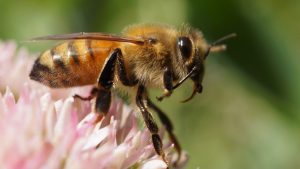A conversation with Indiana’s top honey bee expert
 A honey bee forager cleans herself on a flower
A honey bee forager cleans herself on a flower
FORT WAYNE, Ind. (WPTA21) – Indiana’s pollinators are working overtime on Labor Day to gather every last bit of pollen and nectar they can. Relatively soon, the frost will put an end to the foraging season and pollinators that overwinter will have to rely on what they’ve gathered over the summer.
That’s why honey bees work feverishly to produce as much nectar and store as much pollen as they can.
In honor of our pollinators, we asked Kathleen Prough, Indiana’s Chief Apiary Inspector, a few questions about bees. While we should note that while bees aren’t the only pollinators in our state, they are some of the most commonly observed in the garden.
Agriculture is a pillar of Indiana’s economy. How do you quantify the impact of pollinators, specifically bees, on the industry?
Corn is wind pollinated, so do not need bees. Some varieties of soybeans do have honey bees visiting them. Beekeepers will get some honey from them. Hybrid soybeans are not dependent on insects pollination. Tomatoes are pollinated by bumble bees. Cucumbers in northern Indiana uses honey bee hives for pollination. Major crops that need honey bee hives are melons in southwest Indiana. Bees are also used in fruit tree pollination in spring, then some go into blueberries, strawberries and raspberries.
We all know and love Apis mellifera [honey bee], But what about Indiana’s native bees? Are you particularly keen on any of them?
There are many native bees out there. I love trying to identify native bees on flowers. Honey bees are my favorite since I have been working with them for over 30 years.
The native bee that needs more news about it is the Rusty Patched Bumble Bee. This one is on the endangered species list. It used be found throughout Indiana, but we only have a few areas where they have been found now.
Have you noticed an increase in hobby or “backyard” beekeeping in our state? If so, do you have any numbers to illustrate the growth?
No numbers on how many beekeepers since it is not mandatory for beekeepers to register hives. I estimate around 3,000 beekeepers in Indiana. Majority of these are hobby/sideline beekeepers.
There are new beekeepers every year. We also have newer beekeepers give it up. It is frustrating when your bees die every year. You pay over $100 dollars for a 3 pound package of bees with a queen and they die over the winter. It gets expensive. Plus there is the hive wooden equipment, bee suit, gloves, smoker and hive tool you have to purchase. So it adds up.
If a person is interested in becoming a beekeeper they need to read up on beekeeping, join a local beekeeping club, find a beekeeper to follow for a year, then get bees. They also need to continue learning about honey bees.
One thing they need to know is how to control Varroa mites. This is the biggest pest honey bees have. If varroa mites are not controlled the bee hive could die. Varroa mites can weaken the bees and pass on bee viruses to the bees.






